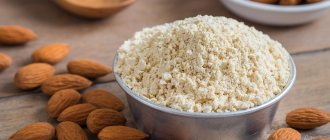The tomato is the edible, often red-colored fruit of the plant Solanum Lycopersicum, commonly known as the tomato. Tomatoes were first used as a food product in Mexico, from where they spread throughout the world after the Spanish colonization of America.
Regardless of how many calories there are in a tomato, this vegetable is used in various forms, including raw, as an ingredient in many dishes, sauces, salads and drinks. The fruits are rich in lycopene, which has a positive effect on the health of the human body.
Tomatoes, whose calorie content depends on the cooking method, belong to the nightshade family. Plants typically reach up to 1-3 meters in height and have weak stems, often grown outdoors in temperate climates and in greenhouses. On average, one tomato weighs about 100 g.
The benefits of tomatoes
Ripe tomatoes are a pharmacy containing vitamins, microelements, antioxidants, which we often lack. Such as:
- Tomatoes contain the most carotene - 400-500 grams of red fruits cover the daily requirement of a substance that is beneficial for the eyes.
- Ascorbic acid and B vitamins promote normal metabolism, increase immunity, and improve skin condition.
- Pink varieties are richest in vitamin C; they also contain selenium, which increases immunity and mental activity.
- Tomatoes contain a lot of potassium and magnesium, which makes them a valuable product for heart patients; potassium helps remove excess fluid and reduces swelling.
- Tomatoes are useful to eat to prevent anemia, because they contain iron and copper, without which hemoglobin synthesis is impossible.
- The seeds of ripe vegetables with the flavonoids surrounding them reduce blood viscosity and prevent the formation of blood clots.
- “Golden apples” contain an abundance of a valuable dye - lycopene - the strongest natural antioxidant. It not only has a beneficial effect on the functioning of the heart, but also prevents the formation of cancer cells. The yellow varieties contain especially a lot of lycopene.
- Tomatoes are the berries of joy - their consumption increases the level of serotonin in the blood, which improves mood and helps overcome depression.
Tomatoes are a real balm for the digestive tract. The watery structure of the vegetable facilitates its digestion in the stomach; the skin promotes peristalsis of the intestinal walls, keeping it “toned.” Tomato diets are popular among those losing weight, because due to their chromium content, these vegetables reduce appetite and cause a long-term feeling of fullness.
Video
The content of useful elements depending on the color of the fruit
The benefits it brings depend on the color of the tomatoes:
- pink ones - they contain more selenium than other types of tomatoes. It is able to prevent the occurrence of neoplasms, activates intestinal peristalsis;
- red varieties have a bright color due to beta-carotene, of which there is a lot, as well as vitamin C. Red varieties contain choline, the benefits of which were discussed earlier;
- yellow fruits are full of retinol, lycopene, myocin. Yellow fruits generally have more pulp and less water. In addition, yellow tomatoes have fewer allergens and are also less likely to cause pain on the mucous membranes of the stomach and intestines;
- green , unripe tomatoes contain solanine, which in large quantities is harmful to the body. Eating green fruits is possible, but only after heat treatment, otherwise you can cause damage to your body.
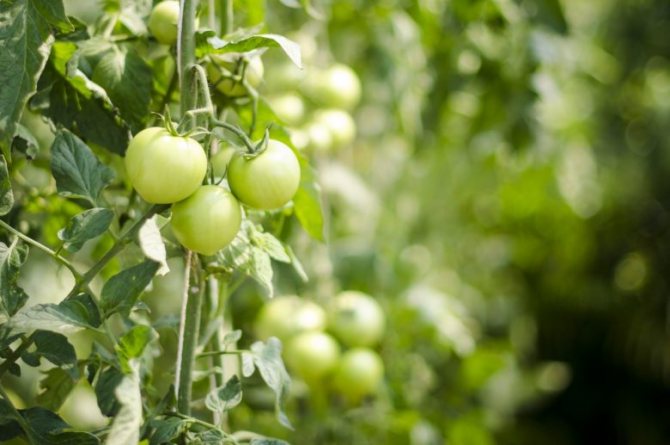
Tomatoes have a lot of benefits for the human body; it is recommended to include them in the diet if there are no contraindications to their use.
There are few contraindications, but they exist:
- tomato is an allergen, if after eating it you notice signs of an allergy, you should not eat it again;
- tomatoes are contraindicated for persons with cholelithiasis;
- people with arthritis and gout;
- In old age, tomatoes carry a risk of forming kidney stones.
Against the background of minor contraindications, a lot of advantages of this vegetable stand out:
- improves the activity of the heart and nervous system;
- useful for gastric diseases - bloating, constipation or gastritis of low acidity;
- is beneficial for high cholesterol levels;
- has a positive effect on the body in case of anemia, weakened memory;
- removes waste, toxins and stagnant fluid from the body;
- is an external remedy for the treatment of inflammation, relieves swelling and reduces pain in varicose veins;
- gives results when losing weight, because the body spends more energy processing tomatoes than it receives calories from them;
- gives a feeling of fullness for a long time, thereby saving you from overeating;
- maintains good skin condition;
- It lifts your mood due to serotonin, and also helps with loss of strength.
What happens if you eat a tomato every day?
Does a tomato have negative calories?
As for the calorie content of a tomato, it should immediately be noted that it is not negative.
Please note: The only food proven to be zero calorie is pure water. It does not contain proteins, fats or carbohydrates, but the body will have to spend several calories to cool or heat the water to body temperature - this will result in a negative calorie effect
Any food product (except water) consists of proteins, fats, and carbohydrates. Their absorption requires 10-15% of the calories they supply to the body.
The composition of BJU in a fresh tomato looks like this:
- Proteins – 0.6 g/100g;
- Fats – 0.2 g/100 g;
- Carbohydrates – 4.2 g/100 g.
You need to add fiber (0.8 g/100 g) and water (93.5 g/100 g) to the tomato BJU - these nutrients do not contain calories. A fresh tomato has a calorie content of about 20 kcal per 100 grams, 3-4 kcal will be spent on its absorption, a small remainder will replenish the body’s calorie reserves. The energy value of tomato is not negative, but low enough that it can be used in weight loss diets.
Is it possible to lose weight on tomatoes: an effective diet
Tomatoes contain a lot of water and fiber, so they fill the body well, neutralize hunger, and although the vegetable does not have the ability to burn fat, they contain many nutrients, including antioxidants, vitamin C and potassium, making a tomato diet healthy and balanced.
If you are puzzled by the question of whether you can lose weight on tomatoes, it will be important to know that tomatoes are classified as foods that have a negative calorie content. This means that the body will spend more energy on digesting tomatoes than it receives from eating them.
So, having decided to use tomatoes, whose calorie content is 16 kcal per 100 g, for weight loss, first of all, you need to be creative in using this vegetable in all dishes throughout the day. Sliced tomatoes can be combined with cottage cheese or herbs, with olive oil, and eaten as a snack or breakfast. They can also be added as a homemade paste to whole grain pasta, brown rice or other dishes instead of canned tomato paste, which is often high in sugar. This homemade tomato sauce (paste) can be prepared in large quantities and stored in the refrigerator, then, no matter what the main dish is chosen, a tasty and healthy gravy will always be ready for it. To prepare tomato sauce, you need coarsely chopped tomatoes, which are known to be low in calories, simmer onions, spices and olive oil over low heat for 15-20 minutes. without adding water.
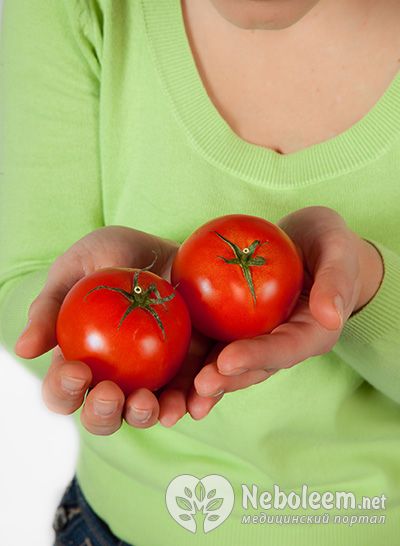
If you are following a diet, the following dishes are ideal for breakfast:
- Several toasted whole grain wheat or rye toasts, on which, instead of the usual pieces of cheese, sausage and butter, you need to put 50 g of fresh tomatoes, whose calorie content is 8 kcal, with herbs, and a cup of natural coffee without milk and sugar;
- A sandwich of whole grain buns, vegetables and fried tomatoes, the calorie content of which is 120-150 kcal, and a cup of natural coffee without milk or sugar;
- Scrambled eggs or omelet with tomatoes, the calorie content of which will be 70-120 kcal, and a cup of natural coffee without milk or sugar.
At lunchtime, a light tomato soup will help you quickly fill your stomach and not gain extra calories. To prepare it, you need to scald several large tomatoes with boiling water, peel them and chop them finely. Then pour 2-3 tbsp into a heated frying pan. olive oil and fry two finely chopped onions until golden brown, add a little crushed garlic and pre-cooked tomatoes, simmer the ingredients for a few minutes and season with spices to taste. You need to cook a light broth on the chicken breast, into which pre-prepared fried tomatoes are added, brought to a boil and sprinkled with fresh herbs on top. The calorie content of tomato soup is on average 50-70 kcal per 100 ml; you can add a small piece of black whole grain bread to it.
For dinner you can eat fresh salads with tomatoes, vegetable stew with tomatoes, tomato juice and 150-200 g of boiled fish or dietary meat. When following a tomato diet, the daily calorie content of which should not be less than 1200 kcal per day, you must consume at least 1.5 liters of water per day.
Dependence of calorie content on cooking method
When figuring out how many calories are in a tomato, you need to consider the method of its preparation.
Table: calorie content of tomatoes for various treatments
| Processing method/grade | Calorie content kcal/100 g |
| Salty | 13 |
| Pickled | 15 |
| Cherry | 15 |
| Pickled | 16 |
| Tomato juice | 18 |
| Fresh | 20 |
| Stewed | 20 |
| Baked | 27 |
| Dried | 258 |
- As can be seen from the table, salted vegetables have the lowest calorie content, while they retain all the vitamin composition and microelements of fresh fruits.
- After cooking, pickled tomatoes lose the lion's share of vitamins, but remain a low-calorie product that is useful for weight loss. A high content of lycopene and essential microelements (potassium, manganese, iron) remains at the bottom.
- The miniature cherry variety quickly gained popularity: small tomatoes are much sweeter and tastier than their large counterparts and can perfectly decorate any dish.
- The value of tomato juice is that it contains more lycopene than fresh vegetables. 1 piece of large fruit weighing 100 g contains 1.5 mg of lycopene, while 100 ml of tomato juice contains 7-8 mg. Two glasses of juice a day will cover the body's daily need for this powerful natural antioxidant.
- Properly prepared stewed and baked tomatoes contain more calories, but they are superior in lycopene content to fresh fruits. 100 g of dish contains less water, but a higher percentage of lycopene and microelements.
- Some meat dishes have fewer calories than canned sun-dried tomatoes, generously seasoned with olive oil. In homemade preparations, they are cooked in dryers for 5 hours at t° = 80° with a lot of salt. Deprived of moisture, sun-dried tomatoes have the maximum content of vitamins and all other beneficial nutrients and are a concentrated medicinal product.
Menu for diet
Fresh tomatoes, which have the lowest calorie content (compared to, for example, fried tomatoes), can be safely included in the diet. However, it is worth considering that tomatoes contain acids that can negatively affect the condition of tooth enamel. Therefore, after each use of tomatoes, it is recommended to brush your teeth.
An approximate menu with tomatoes for a week (5 working days) on a diet is as follows:
- Monday. For breakfast you can eat a slice of bread and a small apple. It is recommended to prepare a summer diet salad for lunch. An orange is a good snack. For dinner you can boil 2 tomatoes and 3 carrots.
- Tuesday. For breakfast, you can drink a glass of yogurt (you should choose low-fat). For lunch, it is recommended to prepare something hot from tomatoes. For example, baked tomatoes are great. An apple is a good snack. For dinner you can make tomato puree soup.
- Wednesday. For breakfast you can eat 2 slices of rye bread. For lunch, it is recommended to prepare tomato pancakes or a steamed omelette (consists of 2 eggs and 2 tomatoes). A glass of tomato juice is ideal as a light snack. For dinner, you can eat a few tomatoes seasoned with spices.
- Thursday. For breakfast you should prepare toast (1 piece). As a dessert, you can treat yourself to an orange. For lunch, you need to boil the tomatoes (they should be very soft) and drink 2.5 cups of the resulting mixture. You can eat 1 tomato for a snack. For dinner, you can prepare a small piece of boiled chicken, and 2 tomatoes are suitable as a side dish.
- Friday. For breakfast you can eat 1 pear and drink a glass of tomato juice. Lunch should be limited to only two tomatoes. 2 small carrots are suitable as a snack. For dinner you can open 1 piece. potatoes, carrots and tomatoes.
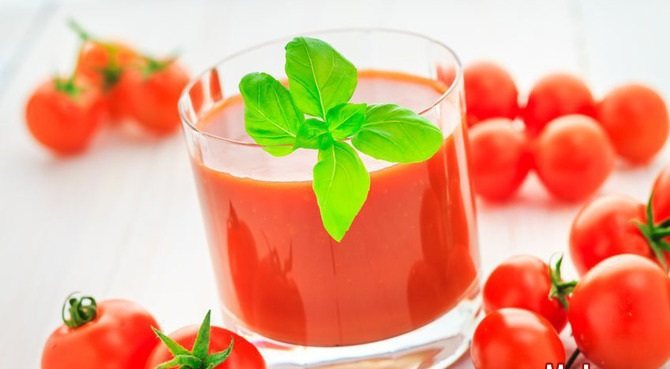
In fact, we are talking about a mono-diet, so such a menu should under no circumstances be used on an ongoing basis. The tomato diet should last 3-5 days, but no more. Otherwise, the body will not receive all the necessary nutrients. It must be remembered that nutrition, first of all, should be balanced.
An important detail is the choice of tomatoes. As you know, store-bought tomatoes are often grown using aggressive fertilizers. Therefore, you need to choose them very carefully, and it is advisable to grow them yourself or buy them from farmers.
If this is not possible, then you should pay attention to several recommendations for choosing fresh tomatoes:
- If the tomatoes look perfect, but they do not have a characteristic aroma, then most likely they are not juicy and completely tasteless. An ideal shape may indicate cultivation with the addition of chemicals. Therefore, it is better to give preference to more “awkward” but aromatic tomatoes.
- A ripe fresh tomato has elastic skin and rich color. If dents are visible on the tomato, one part is soft and the other is hard, then it is better to refuse such a purchase. Also, you should not buy tomatoes, one side of which is still green.
- Before buying tomatoes, you should roughly study the varieties that are presented in stores. If the description indicates that the tomato should be medium in size, but on the market it is twice as large, then there is a high chance that such a berry will turn out to be too watery and tasteless.
- If a tomato smells rotten but looks fresh, you shouldn't buy it.
- It is advisable to buy tomatoes on the branch. If the branch of a store-bought tomato is withered, this indicates that the tomatoes did not ripen naturally and sat for too long. Tomatoes should be selected on green and fragrant branches.
- You should not determine the naturalness and quality of a tomato by its cost. A high price tag may also indicate that the tomatoes were simply transported from afar. Often the most expensive and attractive tomatoes turn out to be tasty.
You can also test fresh tomatoes at home. After buying tomatoes, you should cut one of them at home. If in some places the flesh is green and the skin of the tomato is perfectly red, then this indicates that pesticides were used during the growing process. It is better not to include such tomatoes in your diet.
Tomatoes for weight loss
Despite their low calorie content, tomatoes are not a product that can be regularly used in mono-diets. By eating only vegetables with a minimum content of dietary fatty acids, you can lead your body to exhaustion, disrupt your metabolism, and ruin your health. In addition, tomatoes increase the acidity of gastric juice, and such a mono-diet often ends in gastritis. Oxalic acid, which is rich in bright red vegetables, accelerates the formation of oxalate stones in the kidneys. Tomatoes work effectively for weight loss if you replace one high-calorie meal with them in your daily diet. Instead of an abundance of calories, the body will receive an excellent vitamin supplement that stimulates the gastrointestinal tract, maintaining a feeling of fullness for a long time.
Video
Kinds
There are more than 25,000 different varieties of tomatoes in the world. Conventionally, they are all divided into different groups. For example, tomatoes can be classified based on speed of ripening, stem height, fruit size, and many other factors.
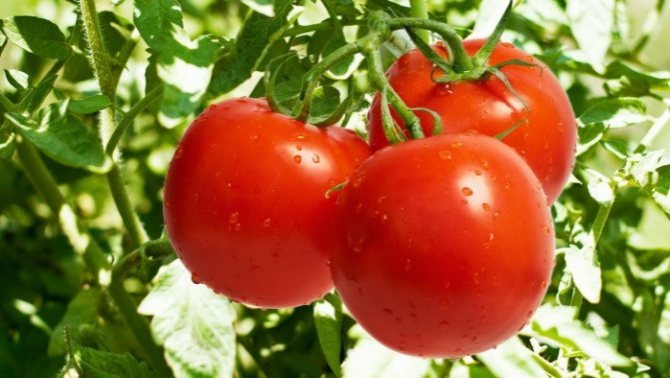
However, the classification according to the purpose of the fruit is more interesting. Knowing the type of tomato, you can determine whether it is suitable for salad or whether it is better to use it for canning.
| Type of tomato | Short description and best varieties |
| For fresh consumption | Juicy, fleshy, quite sweet, with thin delicate skin. It is best to choose beef tomatoes (for example, Ox or Ox heart) or cherry tomatoes (Madeira F1, Pink Cherry). Danko, Infinity, and Nadezhda varieties are also suitable. |
| For recycling | Fleshy, with a small amount of seeds. Not necessarily sweet. The best varieties usually include Mazarin, Babushkin Secret, Ispolin, Cardinal, and Budenovka. |
| For canning | The fruits are small in size, regular round in shape, dense with a fairly hard skin. The most popular varieties are Chocolate Bullet, De Barao, Chibis and Golden Fingers. |
| Universal | The fruits can be used fresh or canned. The best varieties include Alaska, Andromeda and Cio-chio-san. |
In addition, I classify tomatoes by color. Red tomatoes are traditional. They acquire this color thanks to a special pigment called lycoline. This substance is used to prevent cardiovascular diseases, as well as to prevent cancer.
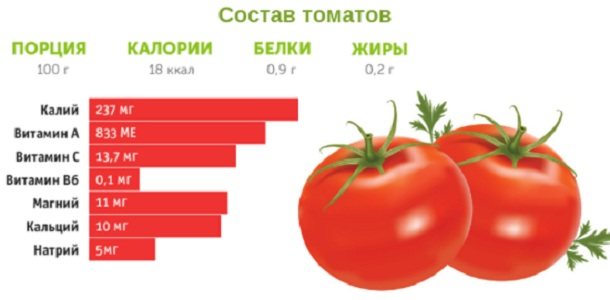
The caloric content of a fresh tomato is undoubtedly important, but this does not mean that you should eat a tomato that looks suspicious.
However, there are very tasty varieties of tomatoes and other flowers:
- Yellow (orange). These varieties contain alpha and beta carotene, as well as vitamin C. These components have a positive effect on vision and skin elasticity. They are also recommended to be preferred for stomach diseases and respiratory problems.
- Pink. They have a sweeter taste and brighter aroma. They contain a large amount of useful microelements, B vitamins, and carotene. It is believed that pink tomatoes have a positive effect on the immune and cardiovascular systems.
- Purple. Such tomatoes contain phenols and anthocyanins. It is thanks to them that the tomato acquires such an interesting shade. Purple tomatoes reduce the risk of stroke and have a general strengthening effect on the heart muscle. They are believed to improve memory.
- Green. Green color is not always a sign of unripe tomatoes. If we are talking about a green-fruited variety, then this is a kind of new product that breeders have developed. Such tomatoes are completely safe for people suffering from allergies. They are also recommended for intolerance to lycopene and anthocyanin (these substances are present in traditional varieties). In addition, green tomatoes contain a large amount of chlorophyll. Therefore, these fruits accelerate wound healing and improve the metabolic process.
- Black. They, like purple tomatoes, contain anthocyanin. However, in addition, such tomatoes are an aphrodisiac and are recommended for the stronger sex.
- White. Tomatoes get this color thanks to anthoxanthin. This pigment affects the improvement of the body’s protective functions, and the substance is also responsible for normalizing blood pressure.
Top 10 vegetables for weight loss
Vegetables for weight loss are not only food with a low amount of calories, but also a source of vitamins, valuable substances necessary for promoting health.
Along with tomatoes, it is useful to involve in the fight against excess weight:
- Eggplants – 4 kcal/100 g;
- Cucumbers – 14 kcal;
- Zucchini – 23 kcal;
- White cabbage – 27 kcal;
- Sweet pepper – 27 kcal;
- Carrots – 34 kcal;
- Greens – 30-50 kcal;
- Onions – 41 kcal;
- Young potatoes – 30 kcal.
The vegetables listed above provide unlimited scope for culinary creativity and will allow you to lose weight tastefully without harming your health. However, it doesn’t hurt to take into account some of the comments of nutritionists.
Video
Vitamins that make tomatoes healthy
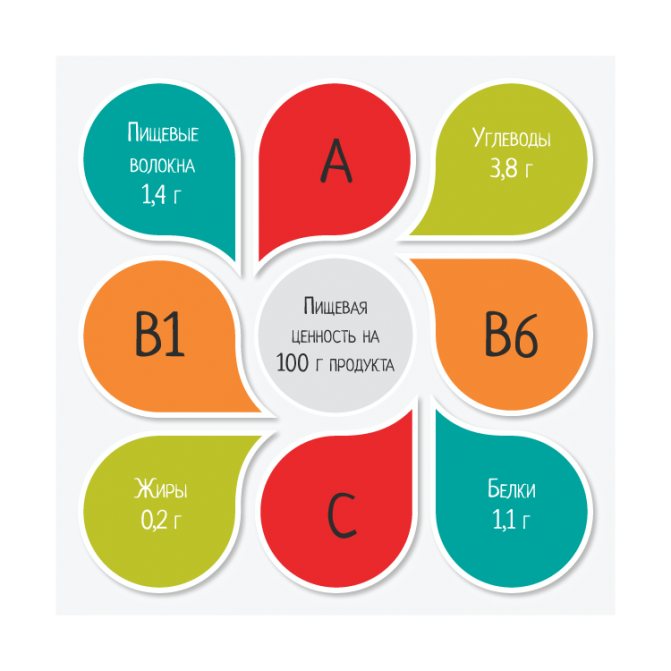
The fact that tomatoes are beneficial is confirmed by the presence of certain vitamins in it. Thus, scientists have identified such groups of vitamin substances in vegetables as:
In addition to a large number of vitamins, the product also contains minerals that are no less beneficial. For this reason, the beneficial effect of the vegetable on humans increases significantly.
Fat-soluble vitamins in tomatoes include A, beta-carotene, alpha-carotene, E and K. Water-soluble vitamins include vitamins C, B1, B2, B3 (PP), B4, B5, B6 and B9.
Vitamins, content Share of the daily norm g 100 per
| Vitamin A | 42.0 mcg | 4,7% |
| Beta carotene | 449.0 mcg | 9,0% |
| Alpha carotene | 101.0 mcg | 2,0% |
| Vitamin D | 0.0 µg | 0,0% |
| Vitamin D2 | n/a | 0,0% |
| Vitamin D3 | n/a | 0,0% |
| Vitamin E | 0.5 mg | 3,7% |
| Vitamin K | 7.9 mcg | 6,6% |
| Vitamin C | 13.7 mg | 15,2% |
| Vitamin B1 | 0.0 mg | 3,1% |
| Vitamin B2 | 0.0 mg | 1,5% |
| Vitamin B3 | 0.6 mg | 3,7% |
| Vitamin B4 | 6.7 mg | 1,3% |
| Vitamin B5 | 0.1 mg | 1,8% |
| Vitamin B6 | 0.1 mg | 6,2% |
| Vitamin B9 | 15.0 mcg | 3,8% |
| Vitamin B12 | 0.0 µg | 0,0% |
| Fat soluble Water soluble |
Beta carotene or vitamin A
Excellent cosmetic product
The presence of vitamin A in tomatoes has a good effect on hair, making it strong and shiny. In addition, tomatoes are good for the eyes, skin, and teeth. 1 cup of crushed tomatoes per day is enough to provide more than half the recommended amount of vitamin A per day.
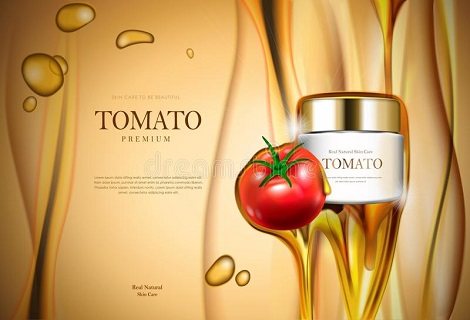
Thiamine or vitamin B1
promotes metabolic processes in the human body, such as carbohydrate, protein, fat, salt. This vitamin is necessary for:
Its deficiency can lead to health problems.
Riboflavin or vitamin B2
necessary for tissue regeneration, including skin. It promotes the healing process of wounds and abrasions, and is involved in the fight against various skin diseases, including psoriasis. Eating tomatoes helps the body cope with colds and stabilizes vision.
Panthenic acid (or vitamin B5)
necessary for the body to:
Pyridoxine or vitamin B6
This vitamin is necessary for the smooth functioning of the nervous system and promotes the production of serotonin (the hormone of joy).
Ascorbic acid or vitamin C
Vitamin C in tomatoes
Tomatoes are a unique storehouse of vitamin C and other antioxidant substances that change metabolism at the level of adipose tissue, increase the intensity of adipocyte oxidation in order to obtain energy to meet the body’s own needs.
Vitamin C also slows down the rate of formation of fat depots (especially abdominal fat).
It is also known that any antioxidants have a pronounced anti-inflammatory effect, and adipose tissue is in a state of constant chronic inflammation. Against the background of inhibition of this process, there is an improvement in microcirculation and metabolism, which can help slow down the deposition of fat in the body and speed up weight loss.
Thus, including tomatoes in your diet helps you lose weight faster and maintain adequate body weight.
Tocopherol or vitamin E
Vitamin K
The amount of vitamin K contained in tomatoes is 0.006 mg. It is necessary for the process of protein synthesis and ensures blood clotting.
Vitamin K in tomatoes
Tomatoes are rich in vitamin K, which is directly involved in bone metabolism.
According to scientists from Denmark, vitamin K activates proteins responsible for the deposition of calcium ions in bones. This strengthens the bones: the mineral density of bone tissue increases, and the risk of developing pathological fractures decreases.
This circumstance is especially important for older people, as well as for women during menopause.
Tomatoes strengthen bones and reduce the likelihood of developing fractures.
Vitamin PP
Maintains the hormonal system in proper condition and is responsible for the endocrine glands of PP, the content of which in tomatoes is 0.6 mg.
Additional vitamin components in tomatoes
Vitamin acids in tomatoes:
Additional important components of tomatoes:
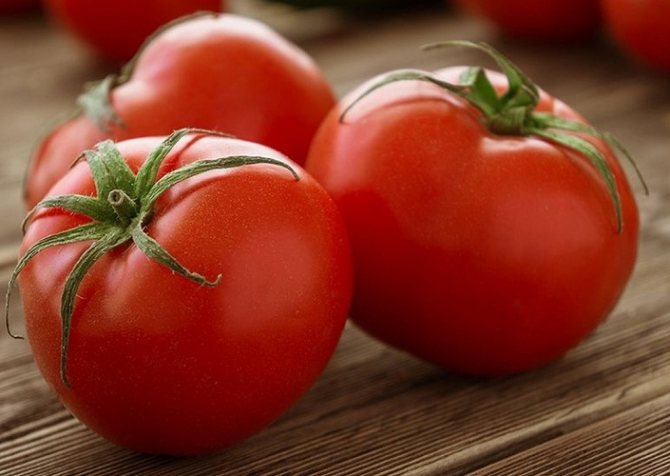
But you can’t overeat tomatoes.
Organic acids
Malic and citric organic acids are substances that can speed up digestive processes.
Daily requirement of vitamins
The required norm for B1, B2, B3 and B6 is about 2 milligrams per day. You need very little vitamin B9 and K - 400 mcg and 100 mcg per day.
One medium tomato satisfies the daily requirement of vitamins B9 and K.
Tomatoes and cucumbers - the effect of eating together
Many people love tomato and cucumber salad, but are these vegetables healthy when eaten together?
- Tomatoes create an acidic environment, cucumbers create an alkaline environment; the interaction of these substances leads to the formation of salts, which can become stones in the kidneys and gall bladder.
- Vitamin C, which tomatoes are so rich in, is neutralized by enzymes from cucumbers. When they are consumed together, the body will not receive ascorbic acid, no matter how many tomatoes we eat.
- To digest food, the liver and pancreas secrete enzymes. Not a single enzyme needed by cucumbers is the same as those released during the digestion of tomatoes. While one vegetable is being digested, another will begin to ferment in the stomach, creating a load on the liver, which protects the body from fermentation products.
Of course, one festive cucumber-tomato salad will not create serious problems, but it is better to regularly consume these vegetables separately.
Video
And a little about secrets...
The story of one of our readers Alina R.:
I was especially depressed about my weight. I gained a lot, after pregnancy I weighed as much as 3 sumo wrestlers together, namely 92 kg with a height of 165. I thought the belly would go away after giving birth, but no, on the contrary, I began to gain weight. How to cope with hormonal changes and obesity? But nothing disfigures or makes a person look younger than his figure. At the age of 20, I first learned that plump girls are called “WOMAN”, and that “they don’t make clothes that size.” Then at the age of 29, divorce from her husband and depression...
But what can you do to lose weight? Laser liposuction surgery? I found out - no less than 5 thousand dollars. Hardware procedures - LPG massage, cavitation, RF lifting, myostimulation? A little more affordable - the course costs from 80 thousand rubles with a nutritionist consultant. You can, of course, try to run on a treadmill until you go crazy.
And when will you find time for all this? And it's still very expensive. Especially now. Therefore, I chose a different method for myself...
Read more >>
How to lose weight correctly
Any strict diet is stressful for the body, which is why it is not able to provide a long-term weight loss effect. The tomato mono-diet can provide results for a short time, when you urgently need to lose a few kilograms. Following it, you need to eat exclusively fresh tomatoes and juice from them for 3 days - without salt, sugar and oil. Only on the second day of the diet are you allowed to eat 400 g of rice. Of course, the two or three kilograms lost in this way are not broken down fat, but the result of being freed from excess fluid and toxins. Only a balanced diet can give reliable results. In the summer, one of the important places in it rightfully belongs to tomatoes.
Mineral composition
The ratio of mineral substances (macro- and microelements) contained in tomatoes is presented in the table using diagrams.
Minerals, content Share of the daily norm g 100 per
| Calcium | 10.0 mg | 1,0% |
| Iron | 0.3 mg | 2,7% |
| Magnesium | 11.0 mg | 2,8% |
| Phosphorus | 24.0 mg | 3,4% |
| Potassium | 237.0 mg | 5,0% |
| Sodium | 5.0 mg | 0,4% |
| Zinc | 0.2 mg | 1,5% |
| Copper | 0.1 mg | 6,6% |
| Manganese | 0.1 mg | 5,0% |
| Selenium | 0.0 µg | 0,0% |
| Fluorine | 2.3 mcg | 0,1% |
Potassium
To prevent water imbalance, a person needs to consume foods that contain the required amount of fluid. Potassium, which is found in the largest quantities in vegetables, can provide a person with uninterrupted functioning of the cardiovascular system.
In order for tomato fruits to have a sufficient amount of minerals, it must be provided with these elements during growth, i.e. Tomatoes grown in poor soil will also be less nutritious.
Iron
Iron is required for high-quality blood serum and to prevent the development of anemia. There is 0.3 mg of it in tomatoes.
Magnesium
The amount of magnesium contained in 100g of tomatoes is 11.0 mg. The main task of this microelement is to help combat nervous system disorders and depressive conditions.
Phosphorus
For any metabolic process occurring in the internal organs of the human body, phosphorus is necessary. There are 24.0 mg of it in 100g of tomatoes.
Calcium
This macronutrient helps strengthen bone tissue. A sufficient amount of it in the human body is evidenced by healthy and beautiful hair, nails, and teeth.
Sodium
The sodium content in tomatoes is about 5.0 mg. It is necessary to regulate the acid-base balance. The proper functioning of the urinary system depends on the presence of this mineral.
The presence of 0.2 mg of zinc allows you to renew epithelial cells and maintain hair in good condition.
Tomatoes have a beneficial effect on the human body
Even small amounts of copper help regulate blood pressure. This trace element is also effective against viral diseases. The peculiarity of copper is its ability to use the amount of iron necessary for the body.
Selenium
The presence of 0.2 mg of selenium in 100 g of tomatoes makes it possible to reduce the risk of cancer. This mineral is also beneficial for the activity of brain cells.
Fluoride in tomato fruits is only 0.002 mg, but the presence of this mineral component makes vegetables beneficial for bone strength and increases the body's resistance to diseases and infections.
Daily norm of microelements
Of all the microelements contained in a tomato, the body has the greatest need for potassium, sodium and calcium - 2.5 grams, 2.3 and 1.3 grams per day, respectively. The need for phosphorus is slightly less – 800 mg. The body needs 400 mg of magnesium per day. The need for iron and zinc is approximately the same - 10-15 mg per day.
Eating tomatoes will help meet the body's need for potassium, which is why people are often advised to eat tomatoes to maintain their cardiovascular system.
Other plant compounds
The levels of vitamins and plant compounds in tomatoes can vary greatly depending on the variety and sampling period (8, 9, 10).
The main plant compounds in tomatoes are:
Chlorophylls and carotenoids such as lycopene are responsible for the rich color of tomatoes.
As the ripening process begins, chlorophyll (green) is broken down and carotenoids (red) are synthesized (15, 16).
Kholin
Containing sufficient amounts of choline in the product allows you to rid the body of excess cholesterol. Its excess negatively affects the circulatory system and promotes the formation of cholesterol plaques, which form blockages in blood vessels. Also, thanks to choline, you can increase hemoglobin levels.
Cellulose
The fiber contained in tomato fruits is a source of beneficial effects on gastric and intestinal microflora. It helps activate digestion processes.
Cellulose
Tomatoes are a good source of fiber, providing approximately 1.5 grams per medium-sized tomato.
Most of the fiber (87%) in tomatoes is insoluble—in the form of hemicellulose, cellulose, and lignin (2).
Fresh tomatoes are low in carbohydrates. The carbohydrates they contain consist mainly of simple sugars and insoluble fiber. These vegetables are mostly made up of water.
Lycopene (lycopene)
Lycopene prevents the development of cancer cells in the prostate gland in men and prevents disease of the ovaries and uterus in women. In fruits with yellow skin, its indicators are significantly higher than in ordinary, red fruits.
This substance is found in larger quantities in processed fruits (stewed or baked). The required daily dose of lycopene is 10-15 mg.
Lycopene
Lycopene, the most abundant carotenoid in ripened tomatoes, is especially noteworthy when it comes to the fruit's plant compounds.
It is found in the highest concentrations in the peel (17, 18).
Generally, the redder the tomato, the more lycopene it contains (19).
Tomato products—such as ketchup, tomato juice, tomato paste, and tomato sauces—are the richest dietary sources of lycopene in the Western diet, providing more than 80% of dietary lycopene (20, 21).
The amount of lycopene in processed tomato products is often much higher than in fresh tomatoes (22, 23).
For example, ketchup boasts 10–14 mg of lycopene per 100 grams, while one small fresh tomato (100 grams) contains only 1–8 mg (24).
However, keep in mind that ketchup is often consumed in very small quantities. Thus, increasing your lycopene intake can be easier by eating unprocessed tomatoes, which also contain much less sugar than ketchup.
The absorption of lycopene can be greatly affected by other foods in your diet. Consuming this plant compound with a fat source can increase its absorption rate by four times (25).
However, not everyone absorbs lycopene at the same rate (26).
Although processed tomato products contain more lycopene, it is still recommended to consume fresh, whole tomatoes whenever possible.
Lycopene is one of the most abundant plant compounds in tomatoes. It is found in the highest concentrations in tomato products such as ketchup, juice, tomato paste and sauce.
To prevent cancer
Tomatoes help prevent several types of cancer. Studies have established that a high percentage of lycopene in tomatoes reduces the chance of developing prostate, stomach and colorectal cancer.
Lycopene is a natural antioxidant that effectively slows down the appearance of cancer cells. After cooking, tomatoes do not lose this substance, but on the contrary, more of it is produced. Therefore, you should use borscht in your menu.

Solanin
Solanine is one of those substances that can cause harm in high concentrations. It is especially abundant in green, unripe tomatoes, which are recommended to be eaten only after heat treatment or in canned form. There are also contraindications to eating tomato fruits, especially in large quantities. This is a stomach ulcer because... tomatoes contain a large amount of organic acids (malic, citric, oxalic), cholelithiasis, and joint diseases. May cause an allergic reaction in some people due to anthocyanin and lycopene content.
Nutritional value of tomatoes
Tomatoes in any form are recommended by nutritionists to combat obesity: this vegetable is low in calories. Thanks to the consumption of tomatoes, you can fight excess weight without harming the body, because this vegetable enriches the diet not only with vitamins and minerals, it contains fiber, pectin and organic acids.
Fiber stimulates intestinal motility, and this is so necessary for people who often adhere to any diets.

